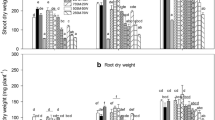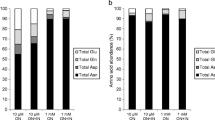Abstract
The duckweed Lemna gibba required light and a suitable energy source such as sucrose, glucose or fructose, for maximum growth in culture. The requirement for light was relatively unimportant and the plants grew well in a photon flux density of only 52 μmol m-2s-1 PAR. The uptake and incorporation of uniformly labelled 14C-glucose into fronds was related only to the concentration of the sugar.
When incubated with soil, labelled L. gibba behaved in a manner similar to that of labelled ryegrass roots which had been produced by a more elaborate technique using a 14CO2 labelled atmosphere. During incubation with soil for 224 days the L. gibba material (specific activity 6133 Bq mg-1 d. wt) lost 64% of its radioactivity as 14CO2 and ryegrass (specific activity 6634 Bq mg-1 d. wt) lost 49%. Alkaline extracted humic and fulvic acids from soil had specific activities for the L. gibba incubation of 3409 and 407 Bq mg-1 solid and for ryegrass roots of 4609 and 546 Bq mg-1 solid respectively. The production of 13C or 14C-labelled L. gibba can be undertaken using only simple equipment producing material the specific radioactivity of which can be controlled by adjusting the activity of the sugar energy source.
Similar content being viewed by others
References
Azam F, Haider K and Malik K A 1985 Transformation of 14C-labelled plant components in soil in relation to immobilisation and remineralisation of 15N fertiliser. Plant and Soil 86, 15–25.
Bacon J S D 1988 Structure and chemistry. In Feed Science. Ed. E RØrskov. pp 33–50. Elsevier Science Publishers, Amsterdam.
Cheshire M V and Mundie C M 1981 The distribution of labelled sugars in soil particle size fractions as a means of distinguishing plant and microbial carbohydrate residues. J. Soil Sci. 32, 605–618.
Cheshire M V, Mundie C M and Shepherd H 1973 The origin of soil polysaccharides: transformations of surgars during the decomposition in soil of plant material labelled with 14C. J. Soil Sci. 24, 54–68.
Cheshire M V, Sparling G P and Mundie C M 1985 The effect of oxidation by periodate on soil carbohydrate derived from plants and microorganisms. J. Soil Sci. 36, 351–356.
Datko A H, Mudd S H and Giovanelli J 1980 Lemna paucisotate Hegelm. 6746. Development of standardized growth conditions suitable for biochemical experimentation. Plant Physiol. 65, 906–912.
DeKock P C and Innes A M 1970 The effect of amitrole on duckweed. Can. J. Bot. 48, 1258–1285.
Glentworth R and Muir J W 1963 The soils of the country round Aberdeen, Inverurie and Fraserburgh. Memories of the Soil Survey of Scotland, Edinburgh, HMSO.
Hewitt E J 1966 Sand and Water Culture Methods used in the study of Plant Nutrition. 2nd edition. pp 83–110. Commonwealth Agricultural Bureau, UK.
Kirk T K, Higuchi T and Chang H-M (Eds.) 1980 Lignin Biodegradation: Microbiology, Chemistry and Potential Applications. Vol. 1. pp 171–194. CRC Press, Boca Raton, Florida.
Jenkinson D S 1965 Studies on the decomposition of plant material in soil. 1. Losses of carbon from 14C-labelled ryegrass incubated with soil in the field. J. Soil Sci. 16, 104–115.
Landolt E 1957 Physiologische und ökologische Untersuchungen an Lemnaceen. Ber. schweiz. bot. Ges. 67, 271–410.
Murayama S 1988 Microbial synthesis of saccharides in soils incubated with 13C-labelled glucose. Soil Biol. Biochem 20, 193–199.
Tachimoto M, Kobayashi M and Takahashi E 1986 Bioassay of decomposed products of rapeseed cake using Lemna paucicostate. Soil Sci. Pl. Nutr. 32, 223–231.
Tasseron-de Jong J G and Veldstra H 1971 Investigations on cytokinins. 11. Interaction of light and cytokinins as studied in Lemna minor. Physiol. Plant. 24, 239–241.
Vaughan D and Ord B G 1985 Soil organic matter turnover. In Soil Organic Matter and Biological Activity. Eds. DVaughan and R EMalcolm. pp 1–35 Martinus Nijhoff-Dr W Junk, Dordrecht.
Vaughan D, Cheshire M V and Mundie C M 1974 Uptake by beetroot tissue and biological activity of 14C-labelled fractions of soil organic matter. Biochem. Soc. Trans. 2, 126–129.
Vaughan D, Russell J D, CheshireM V and FraserA R 1992 The use of chemical and infra-red spectral analyses to verify the identification of two species of duckweed, Lemna minor L. and Lemna gibba L. grown under defined conditions. J. Exp. Bot. 43, 865–870.
Author information
Authors and Affiliations
Rights and permissions
About this article
Cite this article
Vaughan, D., Cheshire, M.V. & Ord, B.G. A simple technique for producing 13C or 14C-labelled fronds of Lemna gibba and their use in soil incubation investigations. Plant Soil 160, 185–191 (1994). https://doi.org/10.1007/BF00010144
Received:
Accepted:
Issue Date:
DOI: https://doi.org/10.1007/BF00010144




